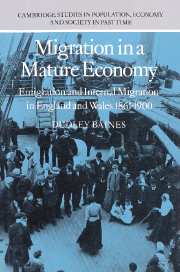Book contents
- Frontmatter
- Contents
- List of tables
- List of figures
- Acknowledgements
- 1 Introduction: the scope of the study
- 2 Issues in the history of European emigration, 1840–1914
- 3 The characteristics of British emigrants before 1914
- 4 The estimation of migration by county of birth
- 5 Return migration to Britain, 1860–1914
- 6 The birthplace of English and Welsh emigrants, 1861–1900
- 7 English and Welsh emigrants in the 1880s and 1890s
- 8 Emigration and urban growth
- 9 Rural-urban stage emigration, 1861–1900
- 10 Wales and the Atlantic economy, 1861–1914
- A summary of conclusions
- Appendices
- Bibliography
- Index
6 - The birthplace of English and Welsh emigrants, 1861–1900
Published online by Cambridge University Press: 24 November 2009
- Frontmatter
- Contents
- List of tables
- List of figures
- Acknowledgements
- 1 Introduction: the scope of the study
- 2 Issues in the history of European emigration, 1840–1914
- 3 The characteristics of British emigrants before 1914
- 4 The estimation of migration by county of birth
- 5 Return migration to Britain, 1860–1914
- 6 The birthplace of English and Welsh emigrants, 1861–1900
- 7 English and Welsh emigrants in the 1880s and 1890s
- 8 Emigration and urban growth
- 9 Rural-urban stage emigration, 1861–1900
- 10 Wales and the Atlantic economy, 1861–1914
- A summary of conclusions
- Appendices
- Bibliography
- Index
Summary
One feature of European emigration before the First World War that has attracted considerable scholarly interest is the marked variance in emigration rates from the different regions of European countries. For example, someone living in the Italian province of Calabria in the early twentieth century was six times more likely to emigrate overseas than someone living in Tuscany. Broadly similar differences in regional emigration rates have been observed in the Scandinavian countries, Germany and Austria–Hungary at various times in the late nineteenth and early twentieth centuries.
The discovery of considerable variance in emigration rates between the different parts of European countries raised some very important issues. There have been attempts to relate regional emigration rates to the economic and social features of the individual regions. But there does not seem to be a simple set of economic and social characteristics that would explain why many emigrants left one area and few left another. For example, research in Scandinavia has shown that emigration rates from urban areas were frequently higher than from rural areas. This has cast some doubt on the view of most of the earlier writers that the bulk of European emigration before the First World War was related to problems within rural society – in particular population pressure and the effect of industrialisation on rural industries. The reason, of course, that emigration rates are difficultto predict from the condition of the areas from which the emigrants came is because emigration seems partly to have been dependent on the flow of information from abroad.
- Type
- Chapter
- Information
- Migration in a Mature EconomyEmigration and Internal Migration in England and Wales 1861–1900, pp. 141 - 177Publisher: Cambridge University PressPrint publication year: 1986



